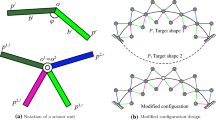Abstract
This paper presents a finite element method for the analysis of scissor-link foldable structures. These structures are capable of deforming from compact form to expanded form, and vice versa. Due to their complex mechanism, it is difficult and time-consuming to simulate foldable structures in analysis softwares, while the proposed method of this paper makes it easy to perform the analysis in a simple manner. In addition, this paper uses two different multi-objective meta-heuristic algorithms, NSGAII and MOCBO, to perform optimum design of foldable structures. The purpose is to find designs that result in minimum weight and minimum volume of the structures satisfying all the constraints consisting of maximum stress, elements buckling, and permissible displacement.














Similar content being viewed by others
References
Mira LA, Thrall AP, De Temmerman N (2014) Deployable scissor arch for transitional shelters. Autom Construct 43:123–131. https://doi.org/10.1016/j.autcon.2014.03.014
Shan W (1992) Computer analysis of foldable structures. Comput Struct 42(6):903–912. https://doi.org/10.1016/0045-7949(92)90102-6
Kaveh A, Davaran A (1996) Analysis of pantograph foldable structures. Comput Struct 59(1):131–140. https://doi.org/10.1016/0045-7949(95)00231-6
Escrig F (1985) Expandable space structures. Int J Space Struct 1(2):79–91. https://doi.org/10.1177/026635118500100203
Hernandez C, Transformables E, Estran I (1988) Geometry of expanable structures. In: Tecnologia y Construction, vol. 4, pp 103–118 (Caracas)
Escrig F, Valcarcel JP (1993) Geometry of expandable space structures. Int J Space Struct 8(1–2):71–84. https://doi.org/10.1177/0266351193008001-208
Escrig F, Sanchez J, Valcarcel JP (1996) Two way deployable spherical grids. Int J Space Struct 11(1–2):257–274. https://doi.org/10.1177/026635119601-231
Escrig F, Sanchez J (2006) New designs and geometries of deployable scissor structures. In: Proceedings of Adaptables2006, TU/e, international conference on adaptable building structures Eindhoven (The Netherlands), pp 5–18
Kaveh A, Mahdavi VR (2014) Colliding bodies optimization: a novel meta-heuristic method. Comput Struct 139:18–27. https://doi.org/10.1016/j.compstruc.2014.04.005
Kaveh A, Ilchi Ghazaan M (2017) A new meta-heuristic algorithm: vibrating particles system. Scientia Iranica Trans A Civ Eng 24(2):551–566
Kaveh A, Dadras A (2017) A novel meta-heuristic optimization algorithm: thermal exchange optimization. Adv Eng Softw 110: 69–84. https://doi.org/10.1016/j.advengsoft.2017.03.014
Kaveh A, Jafarvand A, Barkhordari MA (1999) Optimal design of pantograph foldable structures. Int J Space Struct 14(4):295–302. https://doi.org/10.1260/0266351991494911
Kaveh A, Shojaee S (2004) Optimal design of scissor-link foldable structures using genetic algorithms. Paper 94 from CCP: 80. ISBN:0-948749-98-9
Kaveh A, Shojaee S (2007) Optimal design of scissor-link foldable structures using ant colony optimization algorithm. Comput Aided Civ Infrastruct Eng 22(1):56–64. https://doi.org/10.1111/j.1467-8667.2006.00470.x
Alegria Mira L, Thrall AP, De Temmerman N (2016) The universal scissor component: optimization of a reconfigurable component for deployable scissor structures. Eng Optim 48(2):317–333. https://doi.org/10.1080/0305215X.2015.1011151
Thrall AP, Zhu M, Guest JK, Paya-Zaforteza I, Adriaenssens S (2012) Structural optimization of deploying structures composed of linkages. J Comput Civ Eng 28(3):04014010. https://doi.org/10.1061/(ASCE)CP.1943-5487.0000272
Koumar A, Tysmans T, De Temmerman N, Coelho RF, Mira LA (2014) Multi-criteria optimization of a barrel vault structure for emergency relief. In: Proceedings of the symposium: shells, membranes and spatial structures: footprints (IASS-SLTE’14)
Koumar A, Tysmans T, Filomeno Coelho R, De Temmerman N (2017) An automated structural optimisation methodology for scissor structures using a genetic algorithm. Appl Comput Intell Soft Comput. https://doi.org/10.1155/2017/6843574 2017.
Deb K, Pratap A, Agarwal S, Meyarivan TAMT. (2002) A fast and elitist multiobjective genetic algorithm: NSGA-II. IEEE Trans Evol Comput 6(2):182–197. https://doi.org/10.1109/4235.996017
Panda A, Pani S (2016) Multi-objective colliding bodies optimization. In: Proceedings of fifth international conference on soft computing for problem solving. Springer, Singapore, pp 651–664. https://doi.org/10.1007/978-981-10-0448-3_54
Kaveh A, Ilchi Ghazaan M (2014) Computer codes for colliding bodies optimization and its enhanced version. Int J Optim Civ Eng 4(3):321–332
Gantes CJ, Connor JJ, Logcher RD, Rosenfeld Y (1989) Structural analysis and design of deployable structures. Comput Struct 32(3–4):661–669. https://doi.org/10.1016/0045-7949 (89)90354-4
Author information
Authors and Affiliations
Corresponding author
Additional information
Publisher’s Note
Springer Nature remains neutral with regard to jurisdictional claims in published maps and institutional affiliations.
Rights and permissions
About this article
Cite this article
Kaveh, A., Abedi, M. Analysis and optimal design of scissor-link foldable structures. Engineering with Computers 35, 593–604 (2019). https://doi.org/10.1007/s00366-018-0618-2
Received:
Accepted:
Published:
Issue Date:
DOI: https://doi.org/10.1007/s00366-018-0618-2




